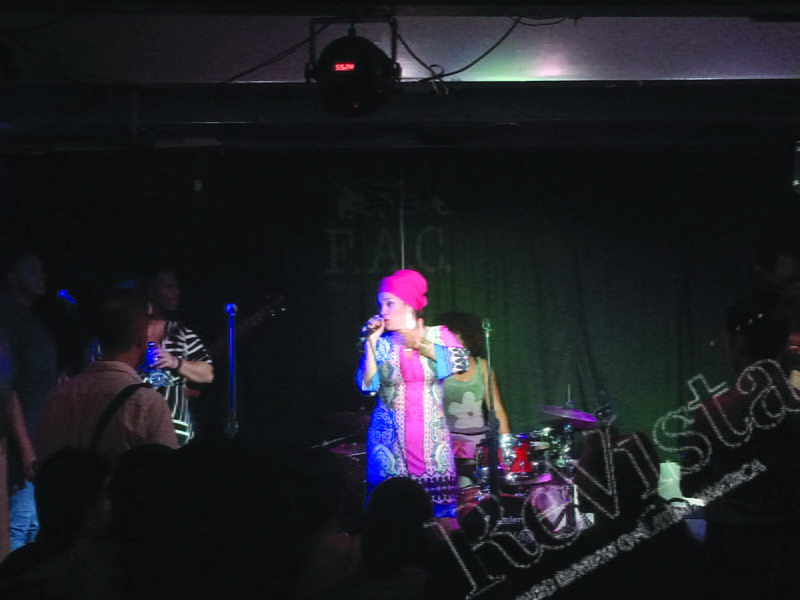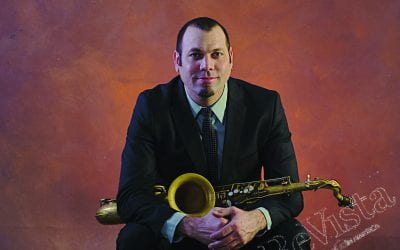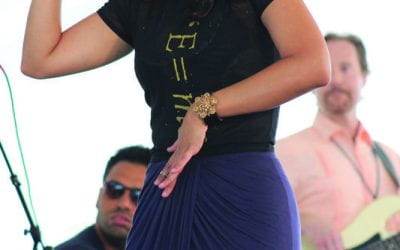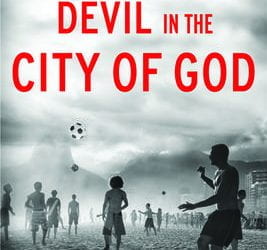La Habana por su música
A Popular Havana Nightclub Hosts a Transnational Music Conference

The Afro-Cuban rock group Síntesis blends music from Santería with elements of progressive rock and jazz. Photo by Matthew Leslie Santana.
My mother left Cuba just before the Bay of Pigs in 1961. She was six years old then, and she has never been back. When I arrived in Havana in June, I became the first person from my generation in my family to step foot on the island. I was there primarily to do preliminary fieldwork as an ethnomusicologist but also to visit the country where my mother was born, to see the church where she was baptized, to take pictures of the apartment she lived in for the first six years of her life.
Though my mother didn’t raise me on a diet of Cuban music, I absorbed a fair amount growing up in Miami. For an island nation with a population smaller than many major cities of the world, Cuba’s music has received a disproportionate amount of attention. Cubans both on the island and in the diaspora are often portrayed as a relentlessly musical people, always ready to dance. You can take salsa lessons in Cambridge, Ann Arbor, Edinburgh and Tokyo.
Perhaps in reaction to this I found myself avoiding organized music events during my time there. It’s not all big bands and dance clubs in Havana. You might notice staggering silence, as I often did in the late evenings on the terrace of my apartment in the Cerro neighborhood of Havana. Or you might stumble upon a toque, a Santería ceremony featuring batá drums, voice and dance. If you spend any time near the Malecón, the sea wall between Havana and the Florida Straits, you will certainly hear vendors singing out their goods: “Maní, pastel de coco, merenguitos” (“peanuts, coconut pastries, merengue”).
My avoidance did not last long, however, as I eventually ran headfirst into the sizeable conference América por su Música (AM-PM; America Through Its Music). Sponsored by the Fábrica de Arte Cubano (Cuban Art Factory) in collaboration with the Centro Nacional de Música Popular (National Center for Popular Music), AM-PM was devoted to the music sector in Latin America and to making musicians and music professionals from the region more visible internationally. The event featured music-related photography exhibits by U.S. artists Petra Richterova and Joe Conzo, Jr., a documentary series on Latin American and Caribbean music and a workshop on live music production, and music management. But the linchpin of AM-PM was a series of sixteen mini-concerts held over four nights at the Fábrica.
First opened in February 2014, the Fábrica de Arte Cubano is a nightclub and exhibition and performance space run by Cuban fusion musician X Alfonso. Housed in a converted olive oil factory, the space has quickly become a gathering spot for many members of Havana’s arts scenes. At any given night at the Fábrica you can hear live music, see a documentary and rotating exhibits of visual art, and perhaps even catch X Alfonso himself enjoying a drink at one of the venue’s several bars.
A veritable who’s who of Cuban music performed at the Fábrica during AM-PM, ranging from the multi-genre singer-songwriter Yusa to the hip hop group Golpe Seko to Haydeé Milanés, the daughter of the nueva trova icon Pablo Milanés. The conference showcased a grab bag of Cuban popular genres: jazz, hip hop, rock, and trova, among others.
On the festival’s opening night, I arrived at the Fábrica just before 11 p.m. I had intended to get there earlier, but my friend Magdalena and I got held up at another performance. My visit to Cuba coincided with the twelfth Havana Biennale, a month-long celebration of global contemporary art. That night, the Canadian duo 2boys.tv had performed their show “Cuerda Floja” at the Hotel Riviera. The performance artists had already been in Cuba for several weeks collaborating with local drag performers, and they had prepared a dramatic show that began in the forecourt of the hotel as the queens filed in to the hotel led by a clarinetist and saxophonist playing George Gershwin’s “Summertime.”
Magdalena and I managed to peel ourselves away halfway through the show to make it to the Fábrica. After catching up with a few of our friends in one of the Fábrica’s two courtyards, we got word that the Cuban hip hop artist Telmary was about to start her set, and we followed the crowd back into the building. Telmary was already on stage when we arrived. She was performing in the smaller of two performance spaces, and it was packed impossibly tight with people trying to get a view. Telmary, who has been on the scene for over a decade, is well known for her unapologetically feminist lyrics and the often breakneck speed of her delivery.
Wearing a dress and a bright pink wrap around her hair, Telmary was flanked by a number of musicians. There were two backup singers, a guitarist, a bassist, a drum kit player, and a man playing auxiliary percussion, trumpet and trombone. The audience erupted when she began her well-known song “Que equivoca’o” (“How mistaken”). “Que equivoca’o tu ‘ta de la vida mi amor, que equivoca’o” (“How mistaken you are about life, my love, how mistaken”), goes the hook, accompanied by a salsa groove. It was particularly exciting to see instrumental music performed live in collaboration with a hip hop artist, a not-too-common sight in the United States right now.
The concert felt like it was over before it began, but such was the design of these numerous mini-concerts, each roughly 45 minutes long. So we filed dutifully into the larger performance space where the Afro-Cuban rock band Síntesis was about to go on. Síntesis is known for their blend of music from Santería with elements of progressive rock and jazz. At this performance there were seven musicians on stage: three singers (one doubling on percussion and another on electric bass), a keyboardist, a guitarist and two percussionists (one on drum kit and the other mostly on congas).
Sound problems plagued the performance—at times the microphone of one of the singers wouldn’t work; frequently the keyboard cut out. While this clearly bothered the band, the audience didn’t seem to mind. The space was full, but the throngs managed to dance and often sing along.
The Fábrica’s size and its popularity mean that it is often so packed that one scarcely has room to shuffle one’s feet, much less dance. Even in the largest performance space, I was often pressed up against any number of sweaty bodies while listening to groups perform. Such was the case with Síntesis. As my friends and I were shuffling together, I noticed a few of them leaning in to speak to one another. When David, shuffling nearest to me, came back a bit closer I asked him what they were talking about. “Que los extranjeros ocupan mucho espacio cuando bailen” (“Foreigners take up a lot of space when they dance”), he told me, gesturing toward the group of U.S. students nearest the stage. “Sí!” I agreed, laughing out loud. And he was right. Though we had accepted our limitation to slight shuffling, those in the group closest to the stage were twirling each other around, creating an increasingly large circle for themselves.
Indeed, there were many extranjeros at the Fábrica each time I went. The audience there has often been described as “bohemian” in various travel magazines. I would describe the clientele as cosmopolitan, well dressed and young. People visiting from all over Latin America and handfuls of North Americans visit the Fábrica, as do young, educated, artsy Cubans. It is safe to say that the Fábrica attracts a particular crowd, one that led one interlocutor of mine to imply that it was the playground of Havana’s burgeoning middle class.
América por su Música successfully brought together musicians, producers and managers to benefit from a well-curated interarts experience. The Facebook page started for the event is still updated frequently with events all over the hemisphere related to the music sector in Latin America. It appears to have provided measurable resources for people working in the music industry in Havana. And the Fábrica seemed to be an ideal and thought-provoking venue for the performances, documentary screenings and exhibition.
Though many spend time worrying about how Havana and Cuba might change in the wake of normalizing relations between Cuba and the United States, it is worth remembering that class formations have long been shifting and responding to tourism in Havana. Visitors from the United States have not yet arrived in droves in Cuba, but at music venues like the Fábrica there is already a fair amount of space being taken up by extranjeros.
Winter 2016, Volume XV, Number 2
Matthew Leslie Santana is a Cuban-American violinist from Miami, Florida. He received his Doctor of Musical Arts from the University of Michigan in 2015 and is currently pursuing a Ph.D. in ethnomusicology at Harvard University.
Related Articles
Musical Identity
English + Español
Frankly, I’m not used to talking about myself, and even less writing about myself. My way of expressing myself has been through musical notes, whether the buoyant Cuban clave rhythms…
Dominican Bachata
English + Español
Ask kids in any U.S. urban middle school if they know who Romeo is. They’ll likely respond with an enthusiastic yes, but their answer will not refer to the Romeo in Shakespeare’s classic play…
Dancing with the Devil in the City of God
Juliana Barbassa and I have similar stories. We are both Brazilian with a chronic case of wanderlust, but in some ways on opposite tracks: Barbassa is from Rio and I am from São Paulo…





